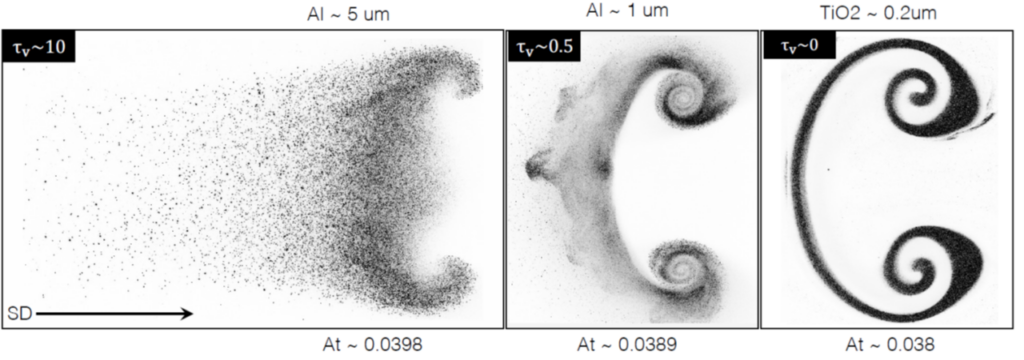The Shock-Driven Multiphase Instability (SDMI) occurs when a multiphase flow field with strong gradients in particle parameters (e.g. number density or diameter) is accelerated by a shock wave. This acceleration deposits vorticity at the interface which causes the multiphase flow field to mix. It is similar to the Richtmyer-Meshkov instability, but as the particle grow in size, they become slow to react and reduce the overall vorticity deposition and mixing. Understanding this instability may lead to new methods for enhancing or limiting mixing in shock driven applications (fusion power, SCRAMjet engines, detonation engines).
Description
The Shock-Driven Multiphase Instability (SDMI) develops when a multiphase interface is impulsively accelerated by a shock wave, developing in a phenomenologically similar manner to a Richtmyer-Meshkov instability (RMI). The multiphase fluid is composed of a gaseous carrier phase and a dispersed particle phase consisting here of spherical non-deforming and non-evaporating solid particles. During the SDMI’s development, the shock wave instantaneously accelerates the carrier gas, while the acceleration of the particles is delayed, depending on their respective mass and drag. Smaller particles will rapidly accelerate to equilibrium, while larger particles will lag significantly, exchanging momentum with the gas over a finite equilibration time. In the limiting case of infinitesimally small particles momentum coupling is nearly instantaneous, and the SDMI and RMI behave similarly.
The RMI is a fluid instability characterized by the development of vorticity due to a misalignment between pressure and density gradients. This misalignment facilitates the deposition of baroclinic vorticity along the interface of fluids with varying densities as can be seen in the enstrophy equation. The baroclinic source term is what characterized the strength of vorticity deposition, which induces an unstable growth in the fluid interface, generating multiple length scales and fostering the mixing of different species across the interface. This dynamic process ultimately leads to turbulent mixing. In addition, when adding particles, the multiphase source term will determine the momentum transfer through the particle drag force. Particles with relatively large diameters will advect through the gas, affecting its momentum over a larger area, resulting in decreased vorticity deposition.
We have collaborated with Los Alamos National Laboratory and Lawrence Livermore National Laboratory to study this problem with their codes in additional to our own. We have also worked with Air Force Research Laboratory and used their computational resources to simulate this problem as part of the summer faculty fellows program.
Our research in this area has been funded by the National Science Foundation.
Images
The image below shows the development of a cylindrical particle laden interface subjected to a Mach 1.35 shock wave resulting in SDMI. Each interface has the same particle mass (effective density, Atwood number) but different particle sizes. The images are taken at the same time but show different development due to the particle size. The image on the right has very small particles in a heavy gas (same effective density as other interface) and shows development much like an RMI. As particle size increases, the circulation (mixing energy) decreases due to particle lagging behind the gas.

Further Reading
- Duke-Walker, V., Agee, S., McFarland, J.A., “Particle Lag Effects in Shock-Driven Multiphase Instability with Solid Particles”, Bulletin of the American Physical Society (2023).
- Duke-Walker, V., Maxon, W.C., Almuhna, S., McFarland, J., “Evaporation and Breakup Effects in the Shock-Driven Multiphase Instability”, J. of Fluid Mech. (2021).
- Duke-Walker, V., Allen, R., Maxon, W.C., McFarland, J.A., “A method for measuring droplet evaporation in a shock-driven multiphase instability”, Int. J. of Multiphase Flow (2020)
- Middlebrooks J., Avgoustopoulos C., Black W., Allen R., McFarland J., “Droplet and Multiphase Effects in a Shock-Driven Hydrodynamic Instability with Reshock“, Exp. in Fluids, (2018).
- Paudel M., Dahal J., McFarland J., “Hydrodynamic effects on particle evaporation in a shock driven multiphase instability”, International Journal of Multiphase Flows, (2018).
- Black W., Denissen N., McFarland J., “Particle Force Model Effects in a Shock-Driven Multiphase Instability”, Shock Waves, (2018).
- Dahal J., McFarland J., “A numerical method for shock driven multiphase flow with evaporating particles”, Journal of Computational Physics (2017).
- Black W., Denissen N., McFarland J., “Evaporation Effects in Shock Driven Multiphase Instabilities”. of Fluids Engineering, (2017).
- McFarland J., Black W., Dahal J., Morgan B., “Computational study of the shock driven instability of a multi-phase particle-gas system”. Physics of Fluids (2016).
